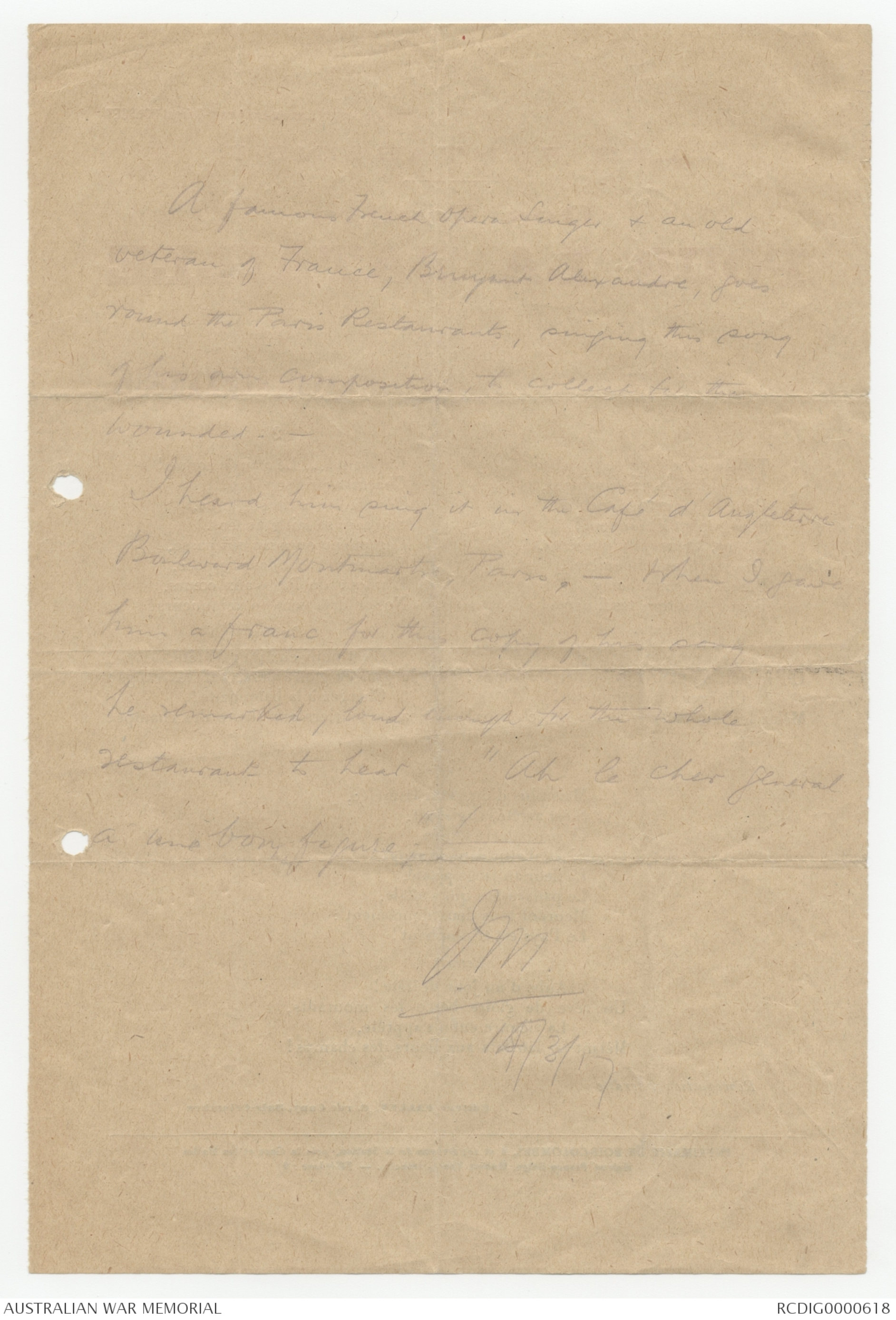Sir John Monash, Personal Files Book 14, 10 February - 30 March 1917, Part 13






A famous French Opera Singer & an old
veteran of France, Bringnant Alexandre, goes
round the Paris Restaurants, singing this song
of his own composition to collect for their
wounded -
I heard him sing it in the Cafe d' Angleterre
Boulevard Montmartre, Paris, - & then I gave
him a franc for this copy of his song
he remarked loud enough for the whole
restaurant to hear "Ah le cher General
a une bon figure"
JM
14/3/17
30/3/1917
[*HEADQUARTERS
No. G45/33
THIRD AUSTRALIAN DIVISION*]
EXTRACTS FROM A REPORT ON MACHINE GUN BARRAGE FIRE
EMPLOYED ON THE SOMME.
The Officers of the Infantry seen are all unanimous
in their estimation of the results obtained by the Machine
Gun Fire in the operations. The absence of rifle fire from
trenches commanding the ground over which the Infantry
advanced was put down largely to the efficiency of the
Machine Gun Fire. There is little doubt that, given a
sufficient number of Machine Guns with well co-ordinated
tasks, a most efficient barrage can be applied instantly
through which no Infantry can progress. This is a valuable
feature immediately after the advance, during the delicate
period of consolidation.
The full efficiency can only be obtained, however, if
good communications are established. Given good communications
various targets can be engaged rapidly by an adequate
number of guns. With bad or indifferent communications
firing can only be done according to a Schedule determined
in advance, unless, of course, direct observation can be
obtained, in which case, naturally, the targets would be
engaged as a matter of course. This, however, can only
be the exception, since the necessity of obtaining a
good clearance over our Infantry forbids the employment of
the Machine Guns so employed too close behind the front
line.
The personnel and equipment of the Machine Gun
Companies is not sufficient for them to undertake the laying
of the necessary telephone lines. The Signal Companies
should be instructed to take into consideration the needs
of the Machine Guns in support, and to establish direct
wires between the O.s C. Groups and the Officer controlling
the Barrage.
The distribution of the guns engaged in Groups under
an O.C. Group gave very good results and in the main it
can be said that all guns were well in hand throughout
the operation.
On the 15th a two-ton lorry was employed all day
long in bringing up ammunition. The large quantities of
ammunition necessary to apply and maintain an efficient
barrage fire requires the creation of S.A.A. Dumps, well
forward at points to be selected beforehand. Also the
O.C. Dump should be instructed to issue S.A.A. to Machine
Gunners on request. During the last operation the Officers
in charge of the Dumps were not always willing to issue
ammunition on account of the small supply of S.A.A. on
hand, and the O.C. Groups had to intervene personally in
several instances to obtain ammunition for the guns.
The Personnel of a Machine Gun Detachment is not
sufficient to bring ammunition forward in an action of
long duration, and in broken ground inaccessible to
anything but foot traffic.
P.T.O.
-2-
It is all they can do to keep the guns firing and refill
the empty belts, without taking into account the improvement
of the positions which must be carried out energetically to
reduce casualties.
The question of the ammunition supply to the guns could
be met by telling off beforehand a permanent carrying party,
the strength of which could be calculated on the basis of
1 man per gun engaged.
The supply of cooling water requires also a great deal
of consideration. It was found that during, continous firing
the evaporation was very great, and that the guns were working
better if the cool water was frequently supplied. Two petrol
tins filled with water were sent up with every gun, and an
additional supply of 40 tins was required on the 15th.
In future operations of this nature, an advanced water
dump will be provided.
The Machine Guns worked very well; quite a number of
muzzle cups were broken, but no guns were out of action for
any length of time, and the stoppages were very few and of
minor importance. The ammunition, although ^of mixed makes,
proved uniformly good.
Regarding the Personnel, it is noted that they worked
with great enthusiasm. Apparently this method of working
appealed to their imagination. Their behaviour was at all
times commendable and although the shell fire was wicked and
they were working in the open, they did not in any way appear
to miss the strong emplacements and shelter to which they were
used.
To:-
The above extract from the report of
a Corps Machine Gun Officer on the Somme, may be of interest
to Machine Gun Officers in your Division.
R.V.K. Applin
Lieut-Colonel.
C.M.G.O.
2nd. Anzac.
Headquarters
March 1917.
16/3/17
Melle Darnon
chez Mme Piatte
22 BD des Moulins
Monte Carlo
Riviera. & Paris
Addresses
March 12th to 20/17
Riviera -
Souvenirs
Hotel & buffet a/s
Tram & train tickets
Nickel 10 centimes piece
Opera tickets - Monte Carlo
 Maralyn K
Maralyn KThis transcription item is now locked to you for editing. To release the lock either Save your changes or Cancel.
This lock will be automatically released after 60 minutes of inactivity.